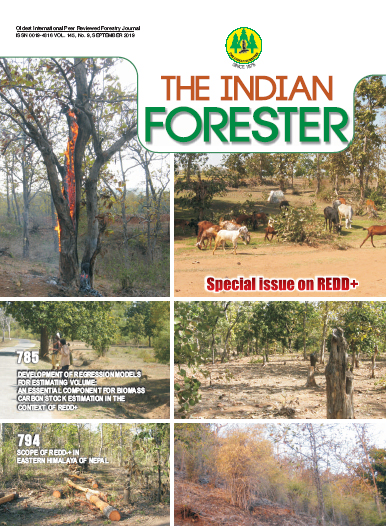Forest Landscape Restoration in Indian Himalayan Region through Implementation of REDD+ Activities
DOI:
https://doi.org/10.36808/if/2019/v145i9/148723Keywords:
Restoration, REDD , Indian Himalayan Region.Abstract
The dynamics of land-use changes and degradation of forests in the Indian Himalayan Region (IHR) have important implications in CO exchange and 2 further contributes to global climatic change. Shifting cultivation, unsustainable fuelwood and fodder collection, invasive species, and forest fire etc. are responsible for degradation of forests in IHR. Himalayan forests have high potential for enhancement of carbon stocks and this can be enhanced through sustainable management of degraded forests. This demand for implementation of REDD+ activities in the IHR which will boost action to curb emissions from deforestation and forest degradation as well as provide a number of non-carbon benefits to the local communities. REDD+ implementation in IHR will support in achieving national targets and international commitments including Bonn challenge target.References
Brown S., Sathaye J, Cannell M. and Kauppi P. (1996). Mitigation of carbon emission to the atmosphere by forest management. Commonwealth Forest. Rev., 75: 80-91.
Buckley L.B. and Roughgarden J. (2004). Biodiversity conservation: effects of changes in climate and land use. Nature, 430: 2-20.
CEDAR (2011). Linking Community Development and Carbon Sequestration to Address Forest Degradation in Uttarakhand Himalaya. CEDAR, Dehradun.
Dasgupta S., Singh T.P. and Rawat R.S. (2015). Assessment of above ground biomass and soil organic carbon stocks in the forests of India. Multi-Scale Forest Biomass Assessment and Monitoring in the Hindu Kush Himalayan Region: A Geospatial Perspective.International Centre for Integrated Mountain Development (ICIMOD). 25pp.
DST (2010). Mission Document on National Mission for Sustaining the Himalayan EcoSystem under National Action Plan on Climate Change. Government of India, Department of Science & Technology, New Delhi.
FAO (1997). Integrating criteria and indicators of sustainable forest management in the national forest programmes. Working document. Food and Agriculture Organization. Rome.
FAO (2015). Global Forest Resources Assessment, 2015. How are the world's forests changing? Second edition. Food and Agriculture Organization. Rome.
FSI (2015). India State of Forest Report, 2015. Forest Survey of India, Dehradun.
FSI (2017). India State of Forest Report, 2017. Forest Survey of India, Dehradun.
Geist H. and Lambin E. (2001). What drives tropical deforestation? A meta-analysis of proximate and underlying causes of deforestation based on subnational case study evidence. Land-Use and Land-Cover Change (LUCC) Project, International Geosphere-Biosphere Programme (IGBP). LUCC Report Series: 4.
Govt. of Uttarakhand (2012). Uttarakhand State Action Plan on Climate Change, Dehradun, Uttarakhand.
ICFRE (2018a). Mizoram State REDD+ Action Plan, Indian Council of Forestry Research and Education, Dehradun (India).
ICFRE (2018b). Uttarakhand State REDD+ Action Plan, Indian Council of Forestry Research and Education, Dehradun (India).
Kaur B., Kaur R., Bhatia S. and Sharma K.K. (2014). Diversity of invasive alien species of Jammu district (Jammu and Kashmir). Inter. J. Interdisciplinary and Multidisciplinary Studies, 1(6): 214-222.
Kosaka Y., Saikia B., Mingki T., Tag H., Riba T., and Ando K. (2010). Roadside distribution patterns of invasive alien plants along an altitudinal gradient in Arunachal Himalaya, India, Mountain Research Development, 30(3):252-258.
MoEFCC (2018). National REDD+ Strategy India, Ministry of Environment, Forest and Climate Change, Government of India.
Mooney H.A., McNeely J.A., Neville L.E., Schei P.J. and Waage J.K. (2004). Invasive Alien Species: Searching for Solutions. Island Press, Washington, D C.
MoSPI (2018). Envi stats India 2018(Supplemental on Environment Accounts). Ministry of Statistics and Programme Implementation. Government of India.
Pau S., Wolkovich E.M., Cook B.I., Davies T.J., Kraft V., Bolmgren K., Betancourt V. and Cleland E.E. (2011): Predicting phenology by integrating ecology, evolution and climate science. Global Change Biology, 17: 3633-3643.
Pandey D.N. (2002). Global climate change and carbon management in multi-functional forests. Current Science, 83(5): 593-602.
Penman J., Wagner F., Tanabe K., Ngara T., Miwa K., Krug T., Buendia L.,GytarskyM., Hiraishi T. Kruger D. and Riitta P. (2003). Definitions and Methodological Options to Inventory Emissions fromDirectHuman-inducedDegradation of Forests andDevegetation of Other Vegetation Types, Hayama, Kanagawa, Japan.
Planning Commission (2010). Report of the Task Force- To look into problems of hill states and hill areas and to suggest ways to ensure that these states and areas do not suffer in any way because of their peculiarities. Planning Commission, Govt. of India, New Delhi. 112 pp.
Rao R.R. (1994). Biodiversity in India: Floristic Aspects, Bishen Singh Mahendra Pal Singh, Dehradun, 1994.
Rawat V.S. (2012). Reducing emission from community forest managements: A feasibility study from Almora, Uttarakhand. Inter. J. Plant Research, 2(6): 181-187.
Samant S.S., Dhar U. and Palni and L.M.S. (1998). Medicinal Plants of Indian Himalaya: Diversity, Distribution, Potential Values, Gyanodaya Prakashan, Nainital.
Sharma C.M., Gairola S., Baduni N.P., Ghildhiyal S.K. and Suyal S. (2011). Variation in carbon stocks on different slope aspects in seven major forest types of temperate region of Garhwal Himalaya, India. J. Biosciences, 36(4):701-708.
Sekar K.C. (2012). Invasive Alien Plants of Indian Himalayan Region- Diversity and Implication. American J. Plant Science, 3: 177-184.
Sekar K.C., Pandey A., Srivastava S.K. and Giri L. (2015). Invasive Alien Plants of Himachal Pradesh, India. Indian Forester, 141(5):520-527.
Singh S.P. (2007). Himalayan Forest Ecosystem Services: Incorporating in National Accounting. Central Himalayan Environment Association, Nainital, Uttarakhand, India, 65 pp.
Singh D.K. and Hajra P.K. (1996). Floristic diversity. In, Biodiversity status in Himalaya (ed. Gujral), British Council, New Delhi, 23-38pp.
Zobel D.B. and Singh S.P.. (1997). Himalayan forests and ecological generalizations. BioScience, 47: 735-745.
Downloads
Downloads
Published
How to Cite
Issue
Section
License
Unless otherwise stated, copyright or similar rights in all materials presented on the site, including graphical images, are owned by Indian Forester.





